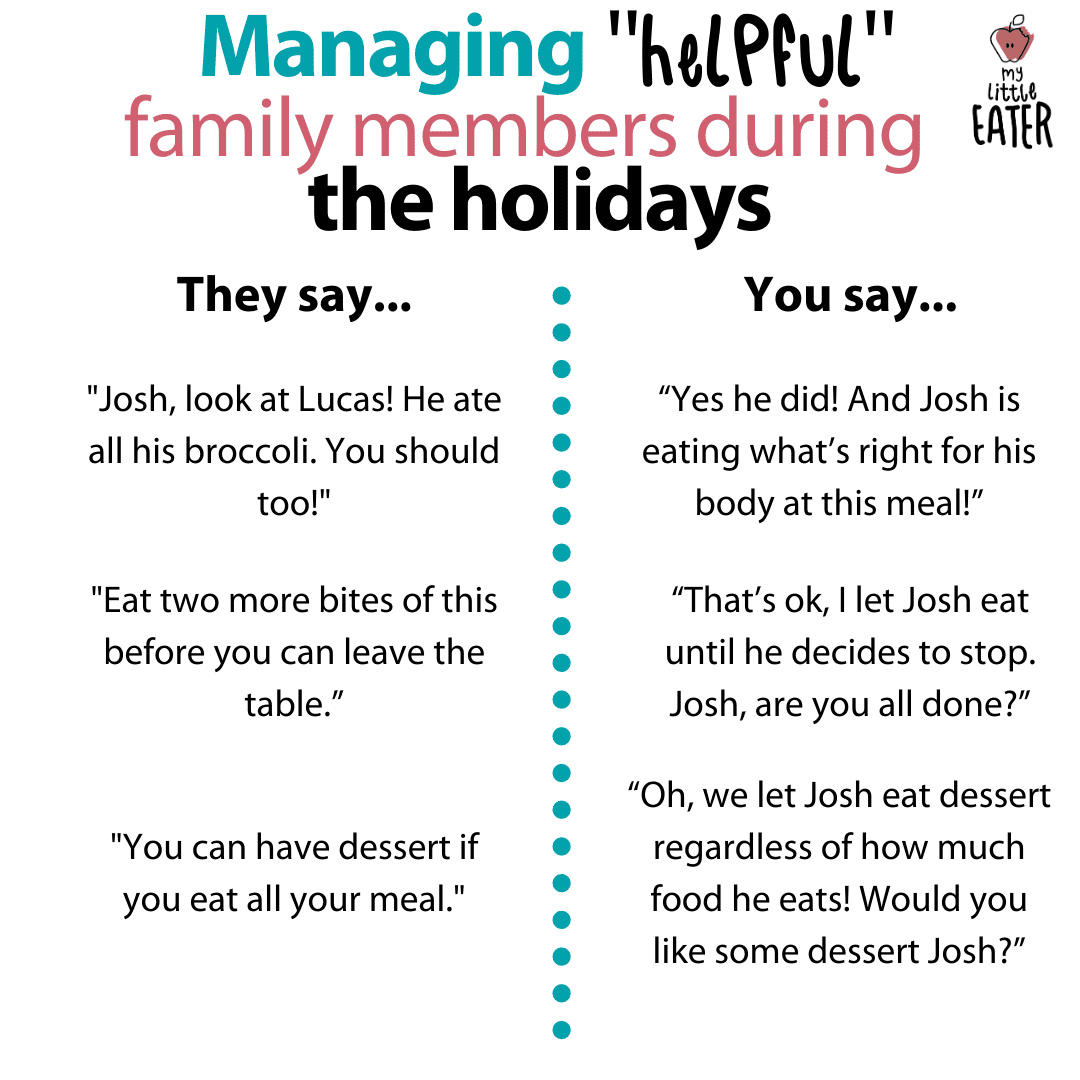
Holiday gatherings are filled with fun, family and (of course)…we can’t forget the food! Food can be a HUGE part of many holiday celebrations, and your family may even have meanings tied to what food choices are made during these celebrations. With so many different people gathered around the table, each with their own feeding philosophies, it can sometimes make for a…erhhhmm…rather interesting dynamic.
You may already be approaching family meals expecting some sort of comment from an opinionated family member (who has good intentions!), but that may follow a feeding style that’s different from the feeding style you follow. You sit down for a family dinner already dreading comments like… “If you eat two more bites of your carrots, you can have dessert!” or “Are you really going to let your son eat all of that candy?”. You may even be tempted to try and avoid the situation completely (and trust me, you wouldn’t be alone in this!). Judgy or pressuring comments can be hard to deal with, no doubt. You may begin to wonder if all your work in raising a healthy eater who has a good relationship with food has gone to waste, and whether you’ll be able to get the progress, that you’ve worked so hard to achieve, back!
As a mother who has seen this many times, I’m here to help lower your stress and help you execute a healthy, and HAPPY, family meal! I’ve gone ahead and addressed some of the common scenarios you may run into, and included some tips on how you can confront these problems, so you and your family can have a stress-free meal experience!
Tip #1: Remember where they’re coming from
It’s always helpful to start off by remembering that the pressure from other family members comes from a place of love. They really do have good intentions! Sometimes family members do this without even realizing that what they’re doing is considered pressuring! As research around feeding styles has developed, changes could have definitely happened from when they raised children of their own, and they simply just might not know that comments like these could have negative effects on mealtime. If holidays are usually the only time you get together with family, they may not be familiar with the amount of food your child chooses to eat, and could genuinely be concerned with making sure they eat enough food to help them stay healthy! (The long gap since you’ve seen them – thanks COVID – could certainly amplify the discrepancy between what they expect your child to eat, and what your child actually will eat.)
Although this may be hard to see at the time, the best thing to do is to take a deep breath, and keep this in mind before proceeding with any action.
Tip #2: Talk about things ahead of time
If you’re going into dinner already expecting that you may run into this problem, it may be helpful to address it before the meal begins, or even before the get together happens. Talking about this in advance, can help eliminate any tension at mealtimes, helps empower family members, and allows them to feel on board with feeding decisions, which can help create a more positive experience for everyone. You could even use this as an opportunity to teach your family about the in’s and out’s of your feeding style, to help eliminate bumping heads at your next gathering!
To help improve their understanding of the feeding style you use, first explain it to them! This will allow for you, and other members of your family who don’t follow the same feeding style, to adjust expectations during the holidays, or to find solutions to any issues you have with one another, in order to resolve things ahead of time. You could simply say something like:
“You know, we’ve been trying a specific feeding style with Josh, and it’s really working out well! I’d love to share it with you and have you help me with implementing it at dinner.”
Then, go ahead and explain the most basic premise:
“We follow the division of responsibility. So I’m in charge of choosing what, when, and where to serve a meal, and Josh is in charge of choosing if and how much he eats. You can follow my lead at mealtime to see how I do it.”
It may also be helpful for them to know important aspects around how you structure your meals, like:
Whether or not you and your child eat together
If you choose to follow this philosophy during the holidays, you could talk to them about the benefits you’ve seen when you include your child during the meal (vs. at a kids’ table or at a different time than you) and how you value their presence during meal times.
What type of serving style you follow (family style or pre-plating)
It would be helpful for them to know if you choose to allow your child to plate their own food, or if you do this for them ahead of time. This may not be much of an issue as many family dinners have much of the food visible for everyone to freely choose the amount they want to eat. And, if you follow family style serving, there’s no reason why your child can’t follow this during a family meal just like they do at home! Let your family members know that you’ll be helping your child pick which foods they want in this case.
Alternatively (if you want to pre-plate), you can say so and add something like “We like to make sure there’s at least one food on the plate he loves, even if it’s just a roll!”. Ideally, you can be the one to pre-plate for him. That way, you can plate the foods you know are familiar, along with smaller portions of the ones you think would be good for him to try. You know your child best, and what they can handle.
How you approach dessert
This seems to be one of the most common issues surrounding get togethers, as everyone has different values on the importance of desserts and sweets. It’s important for everyone to know right away if you choose to allow your child to have dessert, even if they don’t finish their meal, or if you strictly offer it only once they finish. If you’ve completed my Feeding Toddlers course, or just simply follow my work, you may already know the value of including dessert with the meal as a way to remove the “special status” dessert usually holds when it’s offered only at the end of a meal. If this isn’t possible during your family meal, that’s totally okay! Compromise, and just offer the dessert once they’re ready to move on from their meal instead. Ideally, all parents of kids can come up with the same solution together, so as to avoid comparison and meltdowns from one child getting dessert before, or after, another.
How long you expect your child to sit at the table for
This may be a tricky one during the holidays with many distractions or just excitement in general! Fill your family in on the practices you set at home, like whether your child has to sit at the table until their plate is fully finished, or if they can leave once they say they’re full. Let them know how long your child currently sits, and that maybe you’re ok with them staying for only 5 or 10 minutes if distractions are strong, or they aren’t hungry. As graduates of my Feeding Toddlers online course know, we don’t want to force our child to stay at the table until their plate is fully finished – listening to hunger cues is crucial, and that may mean leaving food on the plate. This will most likely come up, especially with older generations, who were always taught not to waste food.
I would suggest approaching this situation kindly, and openly, to help avoid a “you vs. them” scenario. Try to explain your reasoning behind the values you choose. Let your family know the success you’ve had with your choice of feeding style, and how positive the outcome has been since focusing less on the food being eaten, and more on the meal environment itself. Again, this could be a great way to get them on board and help them feel included!
Tip #3: Address comments from family members with grace in the moment

If you’ve been working on setting a positive mealtime environment for your child (and following my work for any length of time), you already know that pressure, be it negative or positive, can be upsetting, and may make your toddler think of mealtimes as a negative experience. If you run into a situation with a family member who’s pressuring your child, I find it’s best, in most situations, to acknowledge the comment courteously, and with subtle redirection. A few examples could be:
“Josh, look at Lucas! He ate all his broccoli. You should too!”
“Yes he did! And Josh is eating what’s right for his body at this meal!”
“Eat two more bites of this before you can leave the table.”
“That’s ok, I let Josh eat until he decides to stop. Josh, are you all done?”
“You can have dessert if you eat all your meal.”
“Oh, we let Josh eat dessert regardless of how much food he eats! Would you like some dessert Josh?”
It’s really up to you and your family dynamics how far you want to go into a conversation about things. But, I find quick and subtle comments, like these, put the power back in your hands without risking an elaborate, and possibly heated, discussion about it. If you notice more push back from a family member, you can end things by saying something like:
“I so appreciate your perspective. Will you follow my lead this meal?”
And smile. It always helps to smile! Although it may be frustrating to address family members who mean well, do so kindly and remember this time is about love, happiness, and family.
Sometimes, talking about your child’s eating habits is nothing more than (what they consider) harmless small talk. It may be easy for someone to comment on a child’s lack of, or abundant eating, as just simply… something to notice and say! It’s helpful in these situations to redirect the conversation away from eating, and onto something else, swiftly and without conflict. For example:
“Oh, he’s picky with his food, isn’t he?”
“He’s doing really well learning to like foods at his own pace! Did you know he’s really into toy cars right now?”
Tip #4: Decide whether it’s worth the effort!
Another thing to consider is how often these occasions happen. Are they once or twice a year, or do you get together more frequently? You may want to choose your battles, say to yourself “Is this something that I really want to fight about for one meal, or not?”. It’s ultimately your choice as the parent, and your choice only, to decide if this occasion will cause a set-back in the progress you’ve made, or if you’re comfortable with letting it slide this one time. If you choose to be lenient and just brush it off, I want to reassure you, once again, to be confident in your choice!
Tip #5: Focus on the positives!
Try focusing on positive experiences during the get together, and not dwelling on the negative. There’s tons of research out there on the benefits of eating together as a family, and the importance of focusing on the togetherness of the meal, instead of the food being served. Even if there’s a bit of tension during the meal, there are many positives you can still appreciate. This is a special time, and this can be forgotten through the hustle and bustle of the season. Having your child participate in the conversations around the table, and passing food around to everyone, can help instill those practices you implement at home, and help your child on the path of becoming an adventurous eater, if they’re not already.
And remember, at the end of the day, the feeding style you choose is your decision and only yours. Be confident that the decision you make is the best for your child, and remind yourself of this often! But also know that sometimes, we just can’t control what others do or say around our kids, and ultimately, a few comments by others here and there aren’t going to undo all that you’ve worked hard to accomplish.
If you’re a parent who loves learning how to raise a happy, healthy eater, I have you covered! Check out my Feeding Toddlers online course to learn how to navigate toddler nutrition, avoid battles at the dinner table, and gain confidence in how you feed your child!






